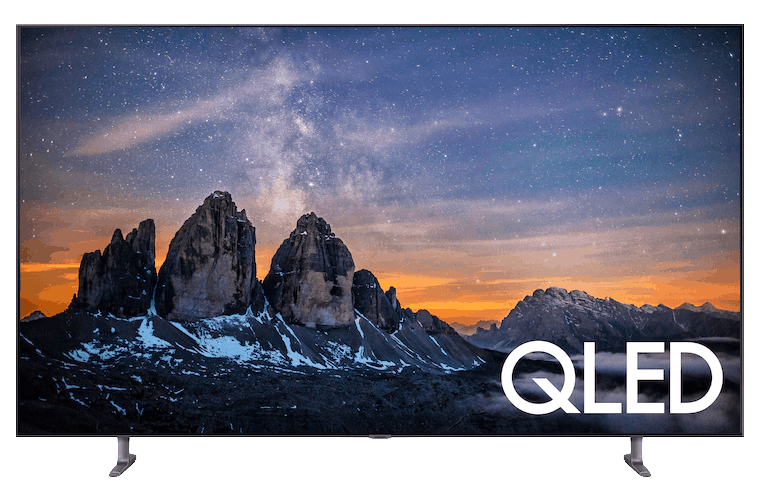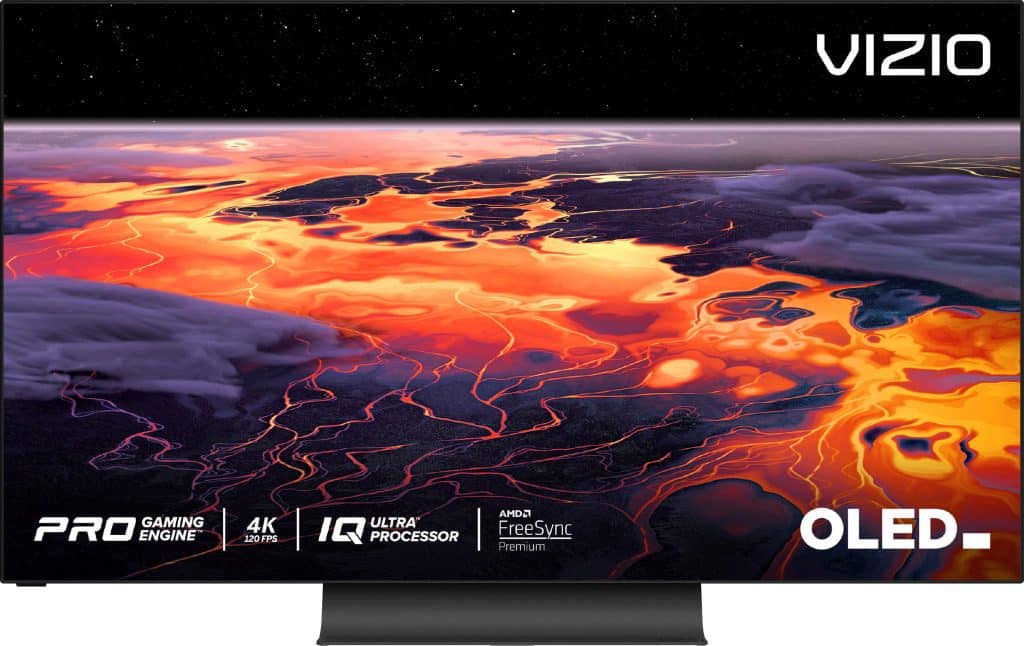When researching brands whose TVs you’d potentially want to buy, Samsung and Vizio are two names that are bound to pop up on your list. Although Samsung is clearly the most reputable worldwide name, Vizio enjoys massive popularity in the consumer TV market, especially in the US.
And, since a new TV, especially a high-end one, is often a large investment for the average household, it’s crucial to do ample research before you commit to a particular TV brand. With that in mind, how do Vizio and Samsung match up against one another? More importantly, which brand is best suited for your needs and budget? Read this detailed Vizio vs Samsung brand comparison page and find out.
Vizio vs Samsung – Quick Comparison
Before we compare the performance features of Vizio and Samsung, let’s do a brief overview of the two companies, starting with the older and more reputable one. Samsung was founded in 1938 in South Korea and has since grown into the 8th highest-valued brand globally. It has built up a reputation for creating high-quality and premium-price TVs.
In comparison, Vizio is a much younger company, founded in 2002 in the USA. Even though it’s been in the business for less than two decades, Vizio has quickly become one of the largest sellers of flat-screen TVs in the US. As of 2021, the company has sold over 80 million LCD, UHD, and OLED TVs.
Features Face to Face
Panel Technology
For over half a decade, Samsung has been using QLED panels for all of its Smart TVs. This technology enables Samsung TVs to provide better colors and deeper blacks. QLED panels successfully tackle the persisting problems LCD TVs suffer from and are more on par with the OLED panel technology.
Vizio has exclusively used LED panels for all of its models over the years. As the name gives it away, LED TVs use LEDs as the light source behind the screen. LED TVs are generally more energy-efficient and have thinner screens than TVs with other panels but can’t provide the rich color palette and deep blacks like QLED panels can.
Besides making LED TVs, Vizio has also created an OLED TV line in 2020, which we’ll primarily focus on in this comparison. OLED TVs offer better performance characteristics than LED TVs and are more comparable to Samsung’s QLED TVs.
Image Processor
Most current Samsung TVs use the Quantum processor, while all of the company’s TVs from 2021 and onward will use the Neo Quantum processor. These powerful image processors utilize AI upscaling technology that provides crisp image quality. This is particularly noticeable in Samsung’s 4K and 8K TVs.
Vizio’s Smart TVs use a Vizio IQ Active image processor. This is a competent TV processor with great noise reducing and detail enhancing properties. Still, it’s hard to come out on top with a tech giant such as Samsung on the opposite side. Considering the essential processing features, Samsung TVs come with better image processors.
Motion Technology
Samsung TVs come with outstanding motion technology. You can expect first-rate 100% response times with minimal blur behind fast-moving objects. Although Samsung models aren’t flicker-free, you won’t notice any annoying flickers during normal viewing conditions.
Vizio LED TVs generally have excellent motion technology with great response times. Its OLED models aren’t as impressive but still provide decent response times. That said, the 100% response time on all Vizio TVs is noticeably slower than on Samsung models, meaning that Samsung is the clear winner in this category.
Picture Quality
Picture quality is undoubtedly a deciding factor when choosing between TV brands. And, although the specific preferences on which users base their perception of picture quality can differ, there’s a clear set of parameters we strictly pay attention to when assessing this category. These include:
Contrast Ratio / Black Level
All Vizio models can provide a very high native contrast ratio. In other words, they can display dark scenes well and produce uniform and deep blacks, especially if you’re watching content in a dark room. This is typical for VA panels, which can display deep blacks even without a local dimming feature.
In comparison, Samsung models also come with an excellent contrast ratio, but it’s still lower than typical for a VA panel. All of this means that Vizio TVs have a slight edge in this category.
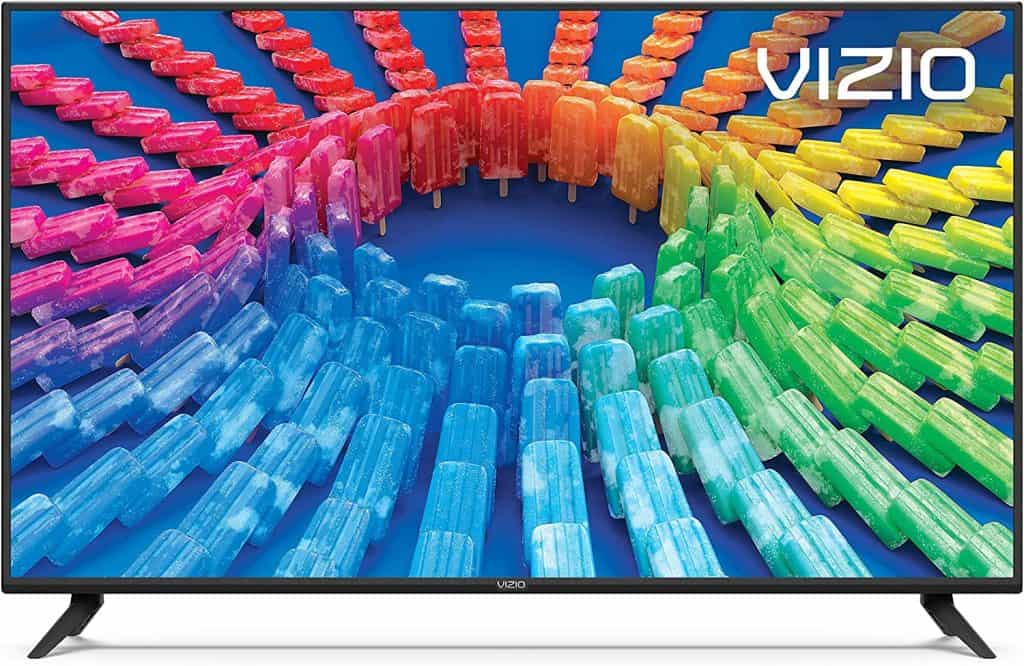
Local Dimming
When it comes to local dimming properties, Vizio TVs can be all over the spectrum. Depending on which LED model you choose, you can experience subpar or excellent local dimming features and anywhere in between. Moreover, their OLED models don’t even have a local dimming feature.
Samsung TVs commonly have decent full-array local dimming properties. Their TVs can sometimes be a bit slow when reacting to changes, which can be noticeable in the screen corners. Still, due to the universally stable properties that mark all Samsung models with local dimming, Samsung is the better performer in this context.
Peak Brightness
Samsung is the superior choice in a direct peak brightness comparison. While some Vizio LED models can provide decent to good peak brightness, this is nowhere near enough to match what Samsung TVs offer. Samsung TVs are good enough to fight glare in bright rooms when displaying both SDR and HDR content and excel when you’re watching content in moderately-lit or dark rooms.
Color
Samsung and Vizio TVs both have the option to enable wide color gamuts. This allows them to provide excellent DCI P3 coverage, key for HDR content. Vizio TVs are slightly better in offering a wider color gamut, as they have better coverage of the wider Rec. 2020 color space.
Samsung TVs are more adept at providing a better color volume, as most Vizio TV models can’t produce very bright colors. However, their perfect contrast ratio enables them to offer deep and saturated dark colors. On the other hand, Samsung models struggle to reproduce dark colors. Considering all of this, Samsung and Vizio TVs have equally superb color properties.
Viewing Angle
As Vizio TVs use OLED and LED screens, they offer much better viewing angles. Even in a wide seating arrangement, Vizio TVs excel in delivering perfect viewing angles. Unfortunately, most Vizio models only start showing brightness loss and dark shades at angles of 70 degrees or more.
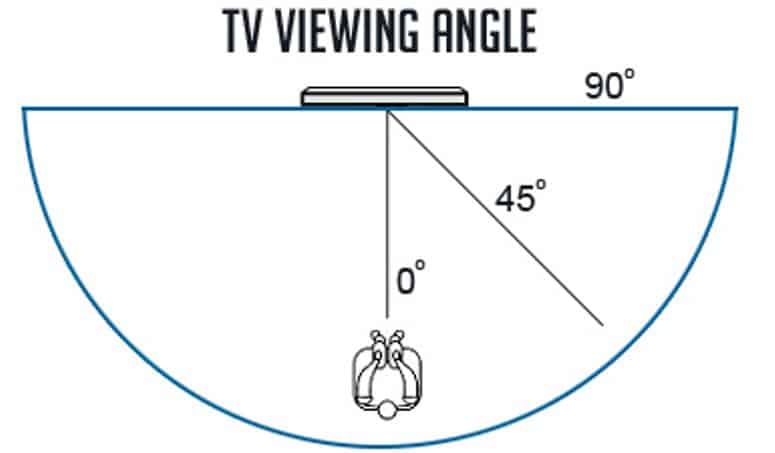
Samsung TVs deliver decent viewing angles but can’t meet Vizio models’ performance characteristics in this category. Gamma shifts and brightness loss tend to appear in most models reasonably quickly once you move off-center. Samsung TVs also come with an Ultra Viewing Angle layer, which does improve viewing angles a bit, but at the cost of a lower contrast ratio.
Reflections / Anti-Glare
Samsung and Vizio models excel in terms of reflection handling. As most of the models, these two brands produce a glossy screen finish and they are very capable of handling reflections and reducing the intensity of reflected light. The two manufacturers are equally impressive in this category. With Samsung and Vizio TVs, visibility shouldn’t be a problem even when you’re watching dark content in a bright room.
Sound Quality
Samsung TVs generally deliver good sound quality. Their TV sets have average frequency response, and the sound is well-balanced. The dialogue always sounds clear, even at higher volume levels, and there’s a solid amount of bass. Many Samsung models also come with a digital room correction feature that tunes the TV’s sound according to your room’s acoustic properties.
Vizio TVs offer decent sound quality, but one that won’t leave you impressed if you’re looking for rich audio or powerful bass. Their TV models can produce thunderous audio, although there is noticeable sound compression when you push the TV close to its maximum volume. Weighing in all of these factors, Samsung TVs offer better sound quality across the board.
Smart TV Platform (Operating System)
Samsung’s Smart TV models all come with the company’s proprietary Tizen operating system. It’s a smooth, user-friendly, and fast OS with tons of advanced options. Vizio also uses an in-house developed OS called SmartCast. It’s a decent Smart TV platform that’s easy to use and comes with plenty of advanced options and settings.
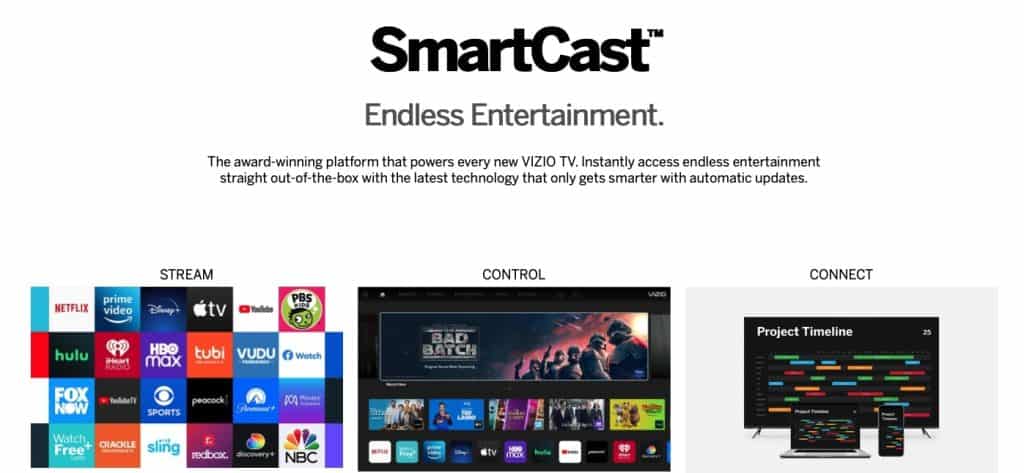
Comparing some key performance characteristics, the Tizen OS is smoother and takes less time to load apps. On the other hand, SmartCast is more responsive and faster when you’re adjusting settings.
Additionally, the Vizio SmartCast OS isn’t as stable as Samsung’s Tizen OS. You may encounter some instability and crashes. Overall, Samsung’s TVs are better performers in this category.
Connectivity
Samsung and Vizio are known for delivering cutting-edge connectivity features in all of their TV models. We’ll match Samsung and Vizio in three key connectivity properties to see just how these two brands stack up in direct comparison.
Inputs
Input specifications can significantly vary between two models from the same manufacturer, let alone when comparing two brands. That said, to make this a comparable category, we’ve picked two TVs in the same price range, the Samsung Q80 and the Vizio OLED 2020. The table below illustrates the input specifications you can expect from both models:
| Input Specs | Vizio OLED 2020 | Samsung Q80 |
|---|---|---|
| HDMI | 4 | 4 |
| HDMI 2.1 | Yes (2 Ports) | Yes (1 Port) |
| USB | 1 | 2 |
| Ethernet | Yes | Yes |
| 5.1 DTS (ARC/Optical) | Yes | No |
| HDR 10+ | Yes | Yes |
| Dolby Vision | Yes | No |
| Price | Check Price on Amazon | Check Price on Amazon |
Voice Assistants
Samsung’s remote controls are noticeably smaller than those that come with Vizio TV sets. However, Samsung remotes are also much more capable than Vizio remotes, as the latter doesn’t come with voice control support. That said, you can still connect your TV to the Google Home network or use a dedicated app.
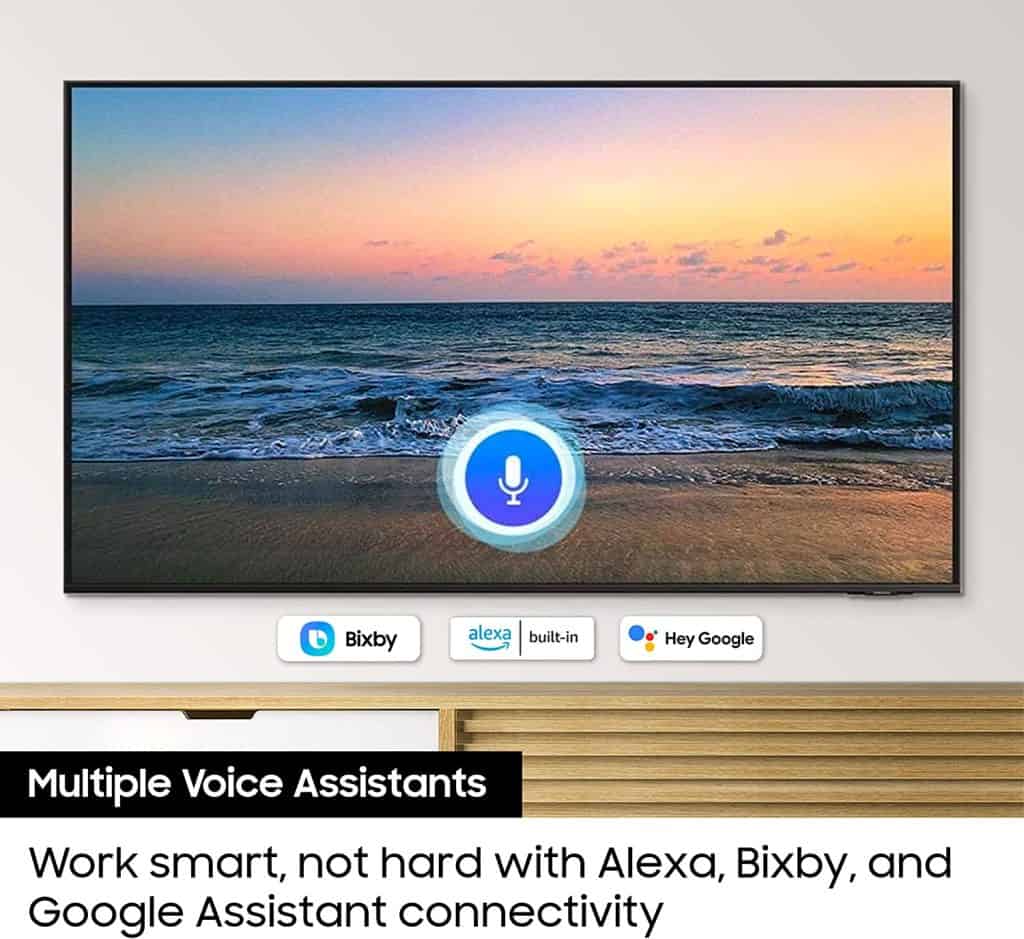
Focusing on Samsung’s voice assistant, Bixby, the company has done a great job developing useful connectivity features for their Smart TV. Utilizing Bixby’s help, you can change channels, search for content, or adjust different settings, all with your voice. The solid voice assistant support gives Samsung TVs the edge in this comparison.
Wireless Technologies
All Samsung and Vizio Smart TV models come with the same Wi-Fi support features, which are 2.4GHz and 5GHz. Many Samsung TVs also include Bluetooth support, allowing you to connect soundbars, speakers, controllers, or any other Bluetooth devices you want to pair up with your TV.
Vizio TV sets currently only support Bluetooth LE, a low-energy form of Bluetooth. This is enough to pair smartphones or tablets with the TV but not powerful enough that you can pair a Bluetooth speaker. The only way to add extra speakers to a Vizio TV is to use the audio port. Primarily because of this, Samsung TVs offer better and more convenient wireless support.
Standout Features
While budget shoppers certainly won’t be disappointed with what Vizio has to offer, Samsung TVs come with some standout features that make them more enticing if you’re ready to spend the extra cash.
Most notably, many Samsung TVs come with both FreeSync and G-SYNC compatibility. This enables them to get the best out of your graphics card when gaming, regardless if you have a Radeon or NVIDIA graphics card. Moreover, Samsung TVs offer significantly better Variable Refresh Rate performance than Vizio models.
Price
As we’ve mentioned throughout this page, Vizio’s business strategy has always been to create TVs that match up to their rival’s TVs but at a lower market price. Because of this, it’s hard to compare the two brands based on this factor.
The best rule of thumb to keep in mind when comparing prices of these two brands is that Vizio TVs are always at least fifteen to twenty percent cheaper than their Samsung counterparts with the same features.
Conclusion
Although the two TV manufacturers go toe to toe in many categories in this Vizio vs Samsung comparison, it’s not difficult to discern which brand is better depending on your budget and preferences.
In nearly two decades since its been in business, Vizio has built up a reputation of offering high-quality TVs at lower prices than its top competitors. Vizio TVs are very capable of providing you with a superb viewing experience, especially if we’re talking about the company’s new OLED TVs. If you’re looking for a good all-around TV, the Vizio brand is an excellent choice.
That said, it’s clear that Samsung is the winner in this duel. This is because it’s better and more reliable in key aspects like picture quality, image processors, and Smart TV features. And, although most Samsung models are more expensive than Vizio TVs with the same specs, the higher price point is certainly worth the quality you’re getting in return. So if you’re looking for a premium TV from a superior brand, Samsung TVs are worth every penny.
